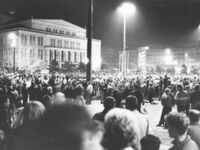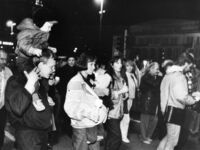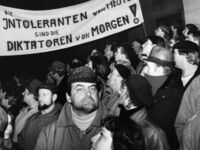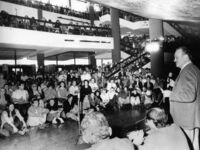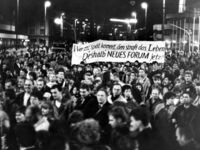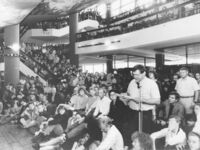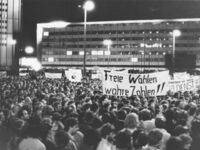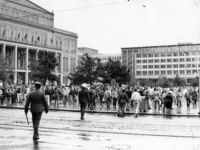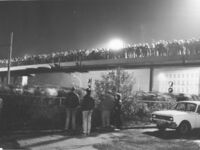Autumn of 1989
Reviewing the historic events of the autumn of 1989
On 11th September 1989 the Bereitschaftspolizei, a kind of paramilitary riot police unit, and the state security service Stasi had almost hermetically sealed off Nikolaikirchhof square in Leipzig. The attendants of the church service were faced with massive barriers. On that day, 104 people were arrested. The East German regime wanted to make an example and therefore acted mercilessly. Some people had to remain in custody until the amnesty at the end of October. In summary proceedings based on penalty orders they were sentenced to four to six months of imprisonment without having had a hearing in advance. The charge: riotous assembly.
The news of the arrests had spread, of course. Prompted by the initiative group Leben (Life) a coordinating group called ‘Leipziger Fürbittandachten für die Inhaftierten’ (Leipzig Intercessory Prayer Meetings for the Arrested) was founded. On 14th September the first intercessory prayer meeting was held among the St. Marcus congregation. The Reformed Church, St. Michael’s and St. Lucas’s Church immediately followed suit. That kind of prayer meetings took root in many towns of East Germany. There were also numerous protest letters addressed to state officials and demanding the civil rights activists to be released from prison. Tobias Hollitzer, director of the Museum in the Round Corner, reviews:
‘Those protests against the Leipzig arrests have significantly contributed to a mobilisation of society in the September of 1989.’
In Leipzig people had meanwhile started to oppose the authorities publicly. The church windows facing Nikolaikirchhof square were constantly decked with fresh flowers and candles. A small poster demanded the prisoners to be released. ‘The brutal course of action of the officials, which was meant to frighten off people, had resulted in the contrary. Many re-discovered their voice and demanded fundamental reforms’ says Hollitzer.
The police operation of the previous week did not keep many people from returning to the Monday prayer on 18th September. Again the police formed compact cordons all around the church, in which about 1,200 people had come together. Pastor Christian Führer informed the attendants of the service about what had happened the Monday before and read to them a list of names of the arrested people. According to the Stasi minutes he explained ‘that the policemen on duty’ were ‘only obeying orders and partly acting against their will.’ The following prayer meeting was arranged by Friedenskreis Lindenau and centred on biblical texts in connection with the topic ‘wall’. Afterwards people again gathered on Nikolaikirchhof, where leaflets with information on the police operation of 11th September were distributed. Once more, law enforcement forces called on the people via loudspeakers to leave the square. At around 6:40 p.m. the square was cleared. More than 30 were arrested on that day.
On 22nd September, SED General Secretary Erich Honecker – who after having been ill for some time had resumed leadership in the Central Committee again – sent a telex to the First Secretaries, the heads of the district administrations, and ordered them ‘to nip these hostile activities in the bud’ and ‘not allow a mass basis for them.’ In addition, ‘the organisers of the counterrevolutionary activities’ were to be ‘isolated’. The next Monday demonstration on 25th September already saw more than 5000 people. They demanded reforms and permission to work for the oppositional organisation Neues Forum, who had been banned by the Ministry of the Interior on that same day.
Based on an article by Mathias Orbeck
published in Leipziger Volkszeitung on 18th September 2009
25th September 1989 was the day of the first major Monday demonstration where people marched along the Leipzig city ring road. St. Nicholas’s Church was filled to capacity during the peace prayer meeting at 5 p. m. On that day the church had to be closed because it could not fit any more people. Outside Bereitschaftspolizei, a kind of paramilitary riot police unit, and state security forces had taken up position again, sealing off Nikolaikirchhof hermetically, just like on the previous Mondays. Despite this presence, approximately 1000 people assembled in front of the church.
Inside, St. Nicholas’s pastor Christian Führer announced that ‘in order to ease the situation’, from now on there would be peace prayer meetings in more Leipzig churches, always on Saturdays. After this, Pastor Christoph Wonneberger conducted the prayer meeting focussing on the topic of violence or force. He preached: ‘Those who seek violence, threaten someone with violence or use it will become victims of violence.’ And: ‘All who draw the sword will die by the sword.’ He explained that this was not meant to question the state’s authority to use force in general. However, state authority had to be controlled effectively – by courts and by parliament … ‘Our country is not rich enough to be able to afford a gigantic security apparatus…’ The basic statement of Wonneberger was: ‘We can do without violence.’
In addition, Frank Richter, a steel construction fitter, reported on violence that he had actually experienced during demonstrations in Leipzig, for example in connection with the fraud at the local elections of May 1989. The singer Christa Mihm struck up ‘We shall overcome’, and the attendants of the worship service joined in.
1500 police forces were on standby. Stasi had initially even intended to use water cannons. This did not happen, however. Minister Erich Mielke and Leipzig’s Stasi lieutenant-general Manfred Hummitzsch agreed on the tactics over the phone. The police was supposed to not escalate the situation or allow provocations. Later the order was issued to ‘arrest the active core’ during one of the demonstrations.
The demonstration started after the prayer meeting. The security forces had blocked the entrance to Markt square, but the police cordon in Grimmaische Straße was disbanded. For this reason the crowd first moved via Ritterstraße to Karl-Marx-Platz square (today: Augustusplatz). More than 5000 people walked along Georgiring, finally passed Central Station and went past the ‘tin can’, as the former Konsument department store was nicknamed. Some chanted demanding ‘Freedom’ and ‘Freedom, Equality, Brotherhood’. The Internationale was raised, too. People demanded the oppositional group Neues Forum to be allowed to work. This had been banned by the Ministry of the Interior on that day and had been rated as subversive.
Initially the police did not interfere. At the pedestrian bridge across Tröndlinring the demonstrators finally turned around. ‘The demonstrators were obviously afraid that the situation might escalate at the Round Corner’, says Tobias Hollitzer, director of the Memorial Museum in the ‘Round Corner’. The police only reacted when about 1000 people wanted to move towards Central Station. Six people were arrested on that evening.
Lieutenant-General Hummitzsch concluded that ’disbanding this kind of crowds’ would no longer be possible without massive police resources. In his report he demanded to prohibit the peace prayer meetings. St. Nicholas’s parish council also took action: ‘We ask you to forego such a show of force by the state authorities’ says a letter written to the district administration of the ruling SED party.
The local newspaper Leipziger Volkszeitung, then the SED district administration’s organ, could no longer ignore what was going on. On 26th September 1989, on the last page, it featured an article under the headline ‘Public order disturbed’ and reported about ‘unauthorised and illegal riotous assemblies in the city centre’ that had ‘disturbed the public order’ and ‘temporarily affected traffic’. The security forces were described as having ‘acted with caution’.
Based on an article by Mathias Orbeck
published in Leipziger Volkszeitung on 25th September 2009
After the first big Monday demonstration on 25th September, when more than 5000 people had for the first time marched from Karl-Marx-Platz via Georgiring to Friedrich-Engels-Platz, the nerves of many officials of the ruling SED party regime were raw. In a rush, measures were taken to fight back ‘antisocialist activities in the city of Leipzig’ allegedly controlled by the West. So, on 29th September, the SED district administration presented a strictly secret argumentative paper. It stated: ‘Leipzig’s city centre is being hyped into an antisocialist pilgrimage place with the aim to affect public order and safety and to severely disturb the normal life of the citizens.
Furthermore, the opposition was described as ‘a group of people cockered up for some time.’ Some of these people were ‘seizing this opportunity now’ and ‘crawling out of their holes like rats.’ Western media, on the other hand, were ‘telling a pack of lies by hyping them up to apostles of freedom.’ ‘People of the cloth’ were also playing an ominous role in ‘stirring up and inciting others to act in an antisocialist way.’ The paper demanded to oppose those machinations ‘with all means, with a high degree of political responsibility and taking action’. Interesting too: The paper was under no circumstances supposed to be copied or passed on, it says.
Additionally, in the LVZ newspaper, at that time district organ of the SED party, there was a reaction in the form of letters to the editor. Under the headline ‘We want to continue living in peace and safety’, Leipzig citizens and a unit of the paramilitary combat troops, the Kampfgruppen, commented on the ‘antisocialist defamation campaign’ on 29th September 1989.
Despite all this, on 2nd October, again a demonstration development, and it became the biggest protest in East Germany since the national uprising in 1953. Just like the Mondays before, the square in front of St. Nicholas’s Church was blocked off by Volkspolizei (the East German police) and by Stasi. The church, in which prior to the prayer meeting about 2500 people had already assembled, again had to be closed because it was filled to capacity. One result was that part of the summoned ‘social forces’ – as described in an encoded telex to General Secretary Erich Honecker – could not manage to get inside the church. Another peace prayer meeting was hosted by the Reformed Church on 2nd October.
More than 20 000 people marched along the ring road on that day, other sources speak about 25 000. In an interview published on the following day, Pastor Christoph Wonneberger said: ‘We have to assume a high degree of spontaneous acting as the demonstration had not been organised by anybody.’ People chanted demanding democratic reforms. One example was: ‘Erich, stop messing, get perestroika in!’ chants like ‘Gorbi, Gorbi’ could be heard, referring to Gorbachev, and ‘Let Neues Forum work!’, referring to a banned oppositional group. Many people made it clear that they wanted more democracy within the country. ‘We are staying here’, was a slogan that could be heard more and more frequently.
At the beginning, the demonstration went uninterrupted, and it passed along the ring road past Central Station to what was then Friedrich-Engels-Platz. There it was stopped by a road blockade of police trucks. Some young demonstrators broke through the police cordon. They went past the ‘Round Corner’, where chants like ‘Out with Stasi’ and ‘Set the arrested people free’ could be heard, and on to Markt square.
After an initial low-key approach, the police started to employ truncheons and electric shock batons. Armed combat troops with workers from large factories, the so-called Kampftruppen der Arbeiterklasse, had also marched up. LVZ reported again about an ‘illegal rout of larger groups of people that affected public safety and street traffic in the city centre.’ On that day 20 men were arrested, most of them were released again on the same evening after having received a warning. Others had to face administrative penalty proceedings.
‘Decisions must be taken whether this worship service that is no longer a worship service can go on’ is what Helmuth Hackenberg, Second Secretary of the SED district administration, wrote to Erich Honecker. He said that those riotous assemblies were increasingly becoming a reservoir of ‘antisocialist and rowdy elements’.
Based on an article by Mathias Orbeck
published in Leipziger Volkszeitung on 29th September 2009
Among the people things had long been bubbling beneath the surface, yet in Berlin the ruling SED party and the government were celebrating the 40th anniversary of the German Democratic Republic. The evening before 100,000 young people had paraded past SED General Secretary Erich Honecker and the guests of honour. There was also a military parade. In Leipzig the security level was at a maximum on the republic’s anniversary day. Even the Kampfgruppen combat groups were on standby. A peace prayer meeting, however, had not been scheduled for that day – the 7th October was a Saturday. Markt square was filled with cheerful crowds - during the annual Market Days.
St. Nicholas’s Church was decked with flowers and candles. On the square in front of the church, at around 10 o’clock in the morning, Volkspolizei police forces noticed the first groups of people gathering peacefully. Via loudspeaker they were told to leave the square. Only half an hour later, the area in front of the church was cleared for the first time. Stasi Lieutenant-General Manfred Hummitzsch had previously given the order: ‘Hostile and negative activities must be curbed resolutely and with all means.’
At 11:40 a. m. the first subdivision of the Volkspolizei alert units took up position, with special equipment. All groups of people were quickly disbanded, just like in a cat and mouse game. All day long the atmosphere remained tense. It was raining. Nobody knew what would happen. Around 1:30 p. m. another 300 people were sighted on Nikolaikirchhof. At that time the security forces had already ‘escorted’ 20 people, as the officials used to put it, which means they were arrested. On the Agra exhibition grounds in Markkleeberg the state security forces had established a central arrest unit, and after first interrogations the detainees were transported there on trucks. People who had been there later described the police operation as brutal. The police marched up fully equipped with helmets and truncheons. They also had dogs with and without muzzle.
The police formed cordons. At around 5 p. m. the Kampfgruppe battalion No. 1 was alerted. In the evening the first water cannons were positioned by the police on Karl-Marx-Platz square (today: Augustusplatz), and they were also used. Spontaneously, a demonstration along the ring road developed again. It was stopped near the main fire station.
Although churches were closed, on 7th October more than 5000 people demonstrated in Leipzig alone. 179 men and 31 women were arrested on that day. This also included 82 people who did not live in Leipzig.
‘They were herded together under shameful conditions in the horse stables on the Agra grounds’, explained Tobias Hollitzer, who is the director of the Museum in the Round Corner. Some people who had been there later reported how the men were dragged down from the trucks. One after the other they were put in front of a wall, their legs parted by truncheon blows. Finally, in groups of ten or more, they were put into the horse boxes. Some had to remain in there for more than 24 hours.
LVZ, then the SED party’s district organ, reported the following Monday, 9th October, under the headline ‘Rowdies affecting a normal life’ that the Deutsche Volkspolizei police forces had prevented major riots and ensured a regular running of the Market Days.
Based on an article by Mathias Orbeck
published in Leipziger Volkszeitung on 7th October 2009
The 9th October 1989 is the date of decision. Since the early morning hours bed sheets have been hanging at St. Nicholas’s Church. ‘Folks, no mindless violence! Hold yourselves in check!’ says the writing on them. Civil rights groups around Pastor Christoph Wonneberger have drafted an appeal, 25,000 copies of which have been produced with great effort and are distributed later. It calls on people to renounce violence.
St. Nicholas’ pastor Christian Führer knows that despite the threats launched by the authorities a huge crowd will assemble for the peace prayer meeting this Monday. There are also threatening phone calls coming in. In schools and companies people have been given official warnings to avoid the city centre because it may be dangerous. Rumours are circulating that hospitals have been ordered to have units of donated blood ready.
The nerves of those working for the authorities are on edge, too. After the previous demonstrations, as for example on 7th October 1989, in Leipzig the authorities want ‘to stop this racket once and for all.’ ‘There have been straightforward threats to employ firearms’, says Tobias Hollitzer, director of the Museum in the Round Corner.
In the early morning, the district administration of SED realizes that demonstrations can no longer be prevented. In order to ‘nip possible provocations in the bud’, 3000 armed forces and 5000 so-called ‘social forces’ are mobilised. SED party members are ordered to gather in St. Nicholas’s Church for the peace prayer meetings. After 2 p. m. the church is filled to capacity. Christian Führer welcomes the comrades: ‘I am happy to see you here, I only wonder why you are so early since the working proletariat only has time after four o’clock in the afternoon.’
Just before 4 p. m. several hundreds of people gather in front of the overcrowded St. Nicholas’s Church. They cannot be admitted. All over the city there are police with dogs. Barred trucks are there, too. Shops and restaurants in the city centre are closed. At 5 p. m. the peace prayer meeting starts. In charge are Pastor Weidel and a peace group from Gohlis. Simultaneous worship services are held in the Reformed Church, St. Michael’s and St. Thomas’s Church, all filled to capacity, too.
At 5:30 p. m. the Leipzig city radio starts broadcasting the appeal of the Leipzig Six: Kurt Masur, Bernd-Lutz Lange, Peter Zimmermann, the SED secretaries Roland Wötzel, Jochen Pommert and Kurt Meyer share the same concern. ‘We are worried about the development in our town and we are looking for a joint solution’, says their appeal. They ask people to act with caution to make a peaceful dialogue possible. The appeal is also passed on by the university theologian Peter Zimmermann during the peace prayer meeting in St. Nicholas’s Church. When about 2000 people leave the church later, they face ten thousands outside. Slowly the demonstration starts moving.
And so the biggest mass demonstration as yet begins to develop, with more than 70 000 people walking from Karl-Marx-Platz (today Augustusplatz) along the ring road. Chants such as ‘Gorbi, Gorbi’ and above all ‘We are the people’ can be heard. There are also demands to give the oppositional group Neues Forum permission to work. Not only Leipzig citizens are there on that day. Thousands of people have come from all over East Germany. The fear of a ‘Chinese solution’ runs deep. Beside police there are also armed Kampfgruppe combat groups there. With candles in their hands people move closer together. There is one slogan that unites them all: ‘No violence’.
Around 6:30 p. m. Helmut Hackenberg, Second Secretary of the SED district administration, phones Egon Krenz. He wants a decision coming ‘from above’. ‘For the first time Egon Krenz did something right since he did not do anything’, Pastor Führer will say later.
Around 7:25 p. m. the situation is again very critical. The demonstration arrives at the Round Corner, the office of the Stasi district administration. The police who have been positioned in front of the building, allow them to pass. However, both sides are extremely worried that the situation may escalate. After having passed the Stasi district building without any incidents or rioting, the demonstrators start cheering. ‘We are the people!’ is again the slogan of the day. ‘We had been prepared for anything but candles and prayers’ is what Stasi boss Mielke will comment later.
Around half past eight the demonstration dissolves. West German television will later show the first reports on Leipzig and the date of decision. Confronted with the huge crowd on the ring road the security forces withdraw. On this day the heavily armed dictatorship has to capitulate in the face of the courage and the will to change that ten thousands of people express peacefully. The GDR, East Germany, has changed. It is the beginning of the end.
Based on an article by Mathias Orbeck
published in Leipziger Volkszeitung on 9th October 2009
